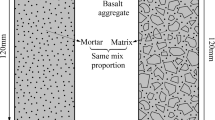Abstract
An orthotropic constitutive relationship with temperature parameters for plain high-strength high-performance concrete (HSHPC) under biaxial compression is developed. It is based on the experiments performed for characterizing the strength and deformation behavior at two strength levels of HSHPC at 7 different stress ratios including α = σ2: σ3 = 0.00: −1, −0.20: −1, −0.30: −1, −0.40: −1, −0.50: −1, −0.75: −1, −1.00: −1, after the exposure to normal and high temperatures of 20, 200, 300, 400, 500 and 600°C, and using a large static-dynamic true triaxial machine. The biaxial tests were performed on 100 mm × 100 mm × 100 mm cubic specimens, and friction-reducing pads were used consisting of three layers of plastic membrane with glycerine in-between for the compressive loading plane. Based on the experimental results, failure modes of HSHPC specimens were described. The principal static compressive strengths, strains at the peak stress and stress-strain curves were measured; and the influence of the temperature and stress ratios on them was also analyzed. The experimental results showed that the uniaxial compressive strength of plain HSHPC after exposure to high temperatures does not decrease dramatically with the increase of temperature. The ratio of the biaxial to its uniaxial compressive strength depends on the stress ratios and brittleness-stiffness of HSHPC after exposure to different temperature levels. Comparison of the stress-strain results obtained from the theoretical model and the experimental data indicates good agreement.
Similar content being viewed by others
References
Li, M., Qian, C.X. and Sun, W., Mechanical properties of high-strength concrete after fire. Cement and Concrete Research, 2004, 34(6): 1001–1005.
Peng, G.F., Yang, W.W., Zhao, J., Liu, Y.F., Bian, S.H. and Zhao, L.H., Explosive spalling and residual mechanical properties of fiber-toughened high-performance concrete subjected to high temperatures. Cement and Concrete Research, 2006, 36(4): 723–727.
Kupfer, H., Behavior of concrete under biaxial stresses. ACI Journal, 1969, 66(8): 656–666.
Husem, M. and Gozutok, S., The effects of low temperature curing on the compressive strength of ordinary and high performance concrete. Construction and Building Materials, 2005, 19(1): 49–53.
Lu, X.B. and Hsu, C.T.T., Behavior of high strength concrete with and without steel fiber reinforcement in triaxial compression. Cement and Concrete Research, 2006, 36(9): 1679–1685.
Luo, X., Sun, W. and Chan, Y.N., Residual compressive strength and microstructure of high performance concrete after exposure to high temperature. Materials and Structures/Materiaux et Constructions, 2000, 33(6): 294–298.
Chan, S.Y.N., Peng, G.F. and Chan, J.K.W., Comparison between high strength concrete and normal strength concrete subjected to high temperature. Materials and Structures/Matdriaux et Constructions, 1996, 29(12): 616–619.
The High-strength High-performance Concrete Committee of China Civil Engineering Society, Guide for Structural Design and Construction of High-strength Concrete. Beijing: China Architecture and Building Press, 2001 (in Chinese).
Guo, Z.H. and Shi, X.D., Reinforced Concrete Theory and Analyse. Beijing: TsingHua University Press, 2003 (in Chinese).
Guo, Z.H., Guo, Y.T., Xu, Y., Ye, X.G. and Li, W.Z., Nonlinear elastic orthotropic constitutive model for concrete. Journal of Tsinghua university (Sci & Tech), 1997, 37(6): 78–81.
Qin, L.K., Song, Y.P., Zhang, Z. and Yu, C.J., The research on strength and deformation of plain concrete under biaxial compression after high temperatures. Journal of Dalian University of Technology, 2005, 45(1): 113–117 (in Chinese).
Author information
Authors and Affiliations
Rights and permissions
About this article
Cite this article
He, Z., Song, Y. Failure Mode and Constitutive Model of Plain High-Strength High-Performance Concrete under Biaxial Compression after Exposure to High Temperatures. Acta Mech. Solida Sin. 21, 149–159 (2008). https://doi.org/10.1007/s10338-008-0818-1
Received:
Revised:
Published:
Issue Date:
DOI: https://doi.org/10.1007/s10338-008-0818-1



